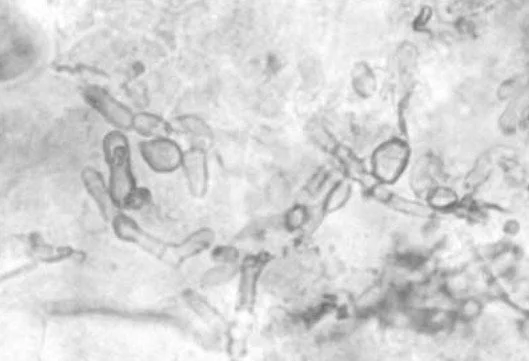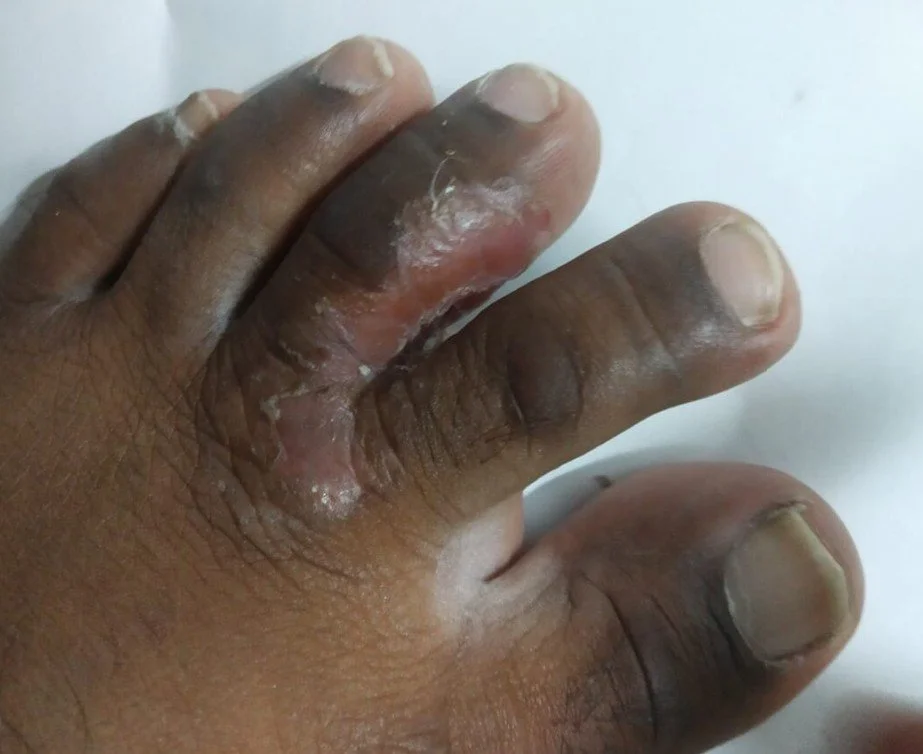Toenail Fungus (Onychomycosis): What Actually Works in 2025
While this is an EXTREME example, Nail fungus can cause considerable changes to the nails and in some cases considerable anxiety about the look of their nails. Lets fix that
TL;DR: If your toenails are thick, yellow, crumbly, or sabotaging your shoes, the highest-odds plan is oral terbinafine with routine debridement, followed by a maintenance phase. ¹–⁶ In our clinic, topicals = CN-U (a compounded high-urea antifungal) or ciclopirox 8%—great for mild disease, as add-ons to pills, and for relapse prevention. ¹,²,⁷–⁹ Nails “clear” by growing out, so think months, not days, and confirm it’s really fungus before you invest the time. ¹,³,¹⁵
How common is this—and who’s at risk?
Onychomycosis affects roughly 13.8% of adults at any given time and thankfully under 1% of kids, which is why you see it on your dad’s feet way more than your daughter’s. ¹,³ Risk rises with age, diabetes, immunocompromise, psoriasis, and the greatest villain of all: tight, sweaty shoes that you never quite let dry. ¹,³
Pediatric Pearl: True nail fungus in kids is rare (~0.44%), so always consider trauma, eczema, or psoriasis first, and screen for predisposing factors (family history, diabetes, immune issues) before you sign them up for a long treatment plan. ¹,³ There are no FDA-approved oral antifungals for children; when needed, therapy is typically topical-first and any systemic use is off-label with specialist oversight. ¹,³.
Nails and skin go together: Ingrown edges often travel with nail fungus. See home care and office options for ingrown toenails. Toe crowding from bunions can also worsen nail changes.
Before we treat: prove its fungus
Half of ugly nails aren’t fungal, and nothing is more demoralizing than three to twelve months of the wrong treatment plan. ¹,³ When stakes are high, considering pills, atypical appearance, prior failures we like to confirm with a nail clipping sent for DNA PCR. This will confirm it truly is a fungus as well as let us know if there are resistance genes present to help guide treatment. ¹,³
We also label what we see—DLSO (most common, stands do Distal Lateral Subungual Nail), superficial white, proximal subungual (watch for immunocompromise), or total dystrophic—because pattern guides expectations/success rates. ¹
Microscope slide showing fungal elements from a nail clipping, proving fungus involvement to indicate need for treatment
What actually works (My clinical protocol)
1) Systemic therapy (first line for moderate–severe)
Terbinafine 250 mg daily × 12 weeks for toenails (6 weeks for fingernails) remains first-line for most adults without contraindications because it wins on both complete and mycologic cure. ¹,²,⁴–⁶ Compared with itraconazole, terbinafine also shows lower long-term relapse in head-to-head data. ¹,³ We obtain baseline LFTs and educate on warning signs; for healthy adults, routine repeat labs aren’t required unless symptoms arise. ²,⁴,⁵ Mind CYP2D6 interactions (certain antidepressants, beta-blockers, codeine/tramadol). ²,⁶ Pair all of this with regular debridement to reduce pressure and help meds reach the target. ²,⁶
Itraconazole (continuous or pulse) is the plan when terbinafine is a no-go or if testing showed Terbinafine resistance, but it brings more interactions and higher 5-year relapse in severe disease. ¹,³
Fluconazole weekly is a third-string option and ONLY used in odd resistance cases or if the PCR confirmed a yeast variant of nail fungus (usually seen in immunocompromised patients)
2) Topicals (how I use them)
CN-U compound (OTC but only dispensed in doctor’s offices): 40% urea base + antifungal soaks into the thickened nail plates and plays nicely with regular debridement. ⁷–⁹ Urea softens and thins the nail, improving penetration and patient comfort, especially when you’re not a candidate for pills or you’re in maintenance mode. ²,⁶–⁹
Ciclopirox 8% lacquer (Rx): Fairly low complete-cure rates in studies, but a no bridges burned option for limited disease and post-cure maintenance—if you’re consistent and we keep the plate thinned you might just get lucky and clear your fungus topically. ¹
If you have failed several options and just want the nail to look less like a fungal nail, Urea Gel 40% is the next best option. It thins the layers of the nail and as the nail gets thinner it will look more ‘normal’. Using Urea along will not resolve fungal infections
(Yes, several other topicals exist including efinaconazole and tavaborole; we prioritize CN-U and ciclopirox for cost, access, and maintenance practicality.) ⁷–⁹,¹⁹
3) Combination therapy
Systemic + topical + debridement is our standard for high-burden disease (≥50% involvement, matrix disease, many nails), after previous solo therapy failures, or with a considerable recurrence ¹⁰
Lasers: why the hype outkicks the data
The “one-visit laser cure” ads are catchy, but the clinical evidence is mixed once you look at data not sponsored by people who want to get laser treatments. ¹¹ Meta-analyses show inconsistent protocols and short follow-up, and placebo-controlled studies show the laser fails to beat placebo in a convincing way. ¹¹ As of 2024–2025, nearly all insurance policies and the FDA still classify lasers for onychomycosis as investigational/not medically necessary/cosmetic, which is short for “we’re not convinced this improves outcomes better than the cheap stuff and therefore aren’t going to pay for you to try.” ¹²–¹⁴
Where lasers fit: occasional adjunct when pills are off the table and expectations are crystal-clear—besides burning a hole in your nail and your wallet it’s a no bridges burned option if you want to try it ¹¹–¹⁴
Surgical options (including a clean reset)
Debridement isn’t optional with thick nails—it enhances drug penetration, relieves pressure, and makes shoes livable. ²,⁶ For refractory, painful, chronically dystrophic nails—or when you want zero maintenance—a permanent matrixectomy (chemically destroy with phenol or surgical excision) stops regrowth. ¹⁰,²⁰–²² You’ll have a bare nail bed cosmetically, but functionally most people feel better and fit shoes better. ²⁰–²² For ingrown nails, we usually perform a partial matrixectomy; for wrecked fungal nails, we talk total. ²¹,²² Simple avulsion plus topical isn’t a great “cure” strategy and isn’t recommended as routine care. ²³ Removing the nail doesn’t speed up the cure rate or improve topical success rates enough to justify the trauma to the toe.
How long until nails look normal?
Toenails creep at ~1.6 mm/month, so a big toe takes 12–18 months to fully replace. ¹⁵ Even with perfect therapy, your “pretty nail” is the new nail to come, not the buzzed-down old onE
Prevention & post-cure maintenance (keep the foot model career going)
Treat the reservoir (tinea pedis): Apply an OTC antifungal to soles and between toes for 2–4 weeks, and restart at the first itch or peel. ¹,¹⁶
Let shoes dry out: Rotate pairs so each rests 24–48 hours; choose breathable uppers and roomy toe boxes. ¹⁶
Smarter socks: Fresh pair daily (twice if sweaty); pick moisture-wicking synthetics or wool; hot-wash/hot-dry when possible. ¹⁶
Shoe hygiene: Antifungal shoe spray or powder after wears; UV shoe sanitizers can reduce fungal load in lab models for footwear that can’t be laundered. ¹⁷ In a pinch, regular Lysol helps a lot too
Nail tools: Don’t share; wipe clippers and files with alcohol; toss disposable files regularly. ¹
Public wet floors: Wear slides in locker rooms and pool decks; dry feet thoroughly before socks. ¹
Topical maintenance : Use CN-U or ciclopirox 2–3 nights/week for 6–12 months on the previously infected nails (and neighbor nails). ¹,¹⁸ Prophylaxis like this cuts recurrence compared with no maintenance. ¹⁸
Pediatric Pearl (household edition): If a parent has athlete’s foot or onychomycosis, kids pick it up from shared floors and showers—keep sandals by the door, don’t share nail tools, or shoes, and treat the grown-up’s tinea pedis aggressively to protect little feet. ¹,¹⁶ While uncommon to go to your kids feet, it’s not impossible.
Common appearance of interdigital tinea pedis (athletes’ foot). It is caused by the same fungus that causes nail fungus. It can act as a living reservoir of fungus causing recurrent infection
Other pains besides your nails?: Plantar heel pain? plantar fasciitis. Burning or pebble‑in‑the‑shoe sensations between toes? Morton’s neuroma.
Special situations (quick hits)
Diabetes/PVD/neuropathy: Thick nails create pressure points that can ulcerate—treat earlier, debride regularly, and prioritize shoe fit. ¹
Immunocompromised: Expect atypical organisms and slower responses; confirm diagnosis and consider longer therapy or alternative agents. ¹,³
Pregnancy/breastfeeding: Favor conservative care and topicals; avoid systemic antifungals unless specialist-directed. ²,⁶
What I’ll likely recommend (cheat sheet)
Mild (≤3 nails, <50%, no matrix): CN-U or ciclopirox daily + debridement; pills optional if you want higher odds or faster progress. ¹,⁷–⁹
Moderate–severe (≥50%, matrix, multiple nails): Terbinafine 12 weeks + debridement; layer CN-U/ciclopirox as clear nail appears and continue 2–3×/week for maintenance. ²,⁶,¹⁰,¹⁸
Terbinafine not an option for allergy, liver, or resistance reasons: Itraconazole (pulse or continuous) or fluconazole weekly (third-string) + the same debridement/maintenance playbook. ¹ Can still always try topicals instead of just giving up when terbinafine isn’t an option.
Toenail Fungus FAQ
Do topical treatments work?
Yes for mild cases with consistent daily use. Thick or long‑standing infections respond better to oral medication or debridement plus topical care.¹
Is nail fungus dangerous?
It is usually a quality‑of‑life issue. People with diabetes or circulation problems should treat it sooner to protect skin and prevent secondary issues.¹
How long until nails look normal?
Toenails grow slowly. Expect visible change after three months and full outgrowth in nine to twelve months.¹
¹ References align with the main article’s citations from peer‑reviewed sources including JFAS, APMA, and AOFAS.
🦶 Recommended Products for Toenail Fungus (Onychomycosis)
These items are listed for education and reference only. They are not a substitute for medical advice. Please see your podiatrist for specific recommendations. I may receive a commission if you purchase through these links, at no additional cost to you.
💅 Skin & Nail Care
- Urea 40% Gel – Softens and thins thick fungal nails so treatments can work better
- Antifungal Shoe Spray – Keeps shoes fungus-free and lowers reinfection risk
- Epsom Salts – Classic soak to calm soreness around toenails
🔧 Tools
- Barrel Hinged Nail Nipper – Heavy-duty clipper for thickened or brittle nails
References
Frazier WT, et al. Onychomycosis: Rapid Evidence Review. Am Fam Physician. 2021;104(4):359–367.
LAMISIL (terbinafine) tablets—US Prescribing Information. Latest label.
Gupta AK, et al. Diagnosis & Management of Onychomycosis. BMJ. 2022;376:e064994.
Stolmeier DA, et al. Laboratory Monitoring During Terbinafine Therapy. JAMA Dermatol. 2018;154(11):1315–1321.
Patel D, et al. Monitoring with Systemic Terbinafine—Retrospective Review. JAMA Dermatol. 2017.
Bodman MA. Onychomycosis. StatPearls. Updated 2024.
Dars S, et al. Urea for Onychomycosis—Systematic Review. J Foot Ankle Res. 2019.
Annunziata MC, et al. Urea-containing Topicals Improve Penetration. Int J Clin Pract. 2020.
Shemer A, et al. Urea + Bifonazole Chemical Avulsion. Clin Cosmet Investig Dermatol. 2020.
Gupta AK, Versteeg SG. Combination Therapy for Onychomycosis. J Am Acad Dermatol. 2017;76(3):e87–e88.
Meretsky CR, et al. Laser vs Other Methods—Systematic Review/Meta-analysis. Cureus. 2024.
FEP/Blue Cross. Laser Treatment of Onychomycosis—Policy. 2024.
Anthem/Healthy Blue. Laser for Onychomycosis (Investigational/Not Medically Necessary). 2025.
Blue Cross MA. Laser Treatment of Onychomycosis—Medical Policy. 2025.
Yaemsiri S, et al. Human Nail Growth Rate (~1.6 mm/mo). JEADV. 2010;24(3):420–423.
Ameen M, et al. Guidelines for Tinea Pedis. Br J Dermatol. 2014;171(6):937–958.
Ghannoum MA, et al. UV Shoe Sanitizer—Infected Shoe Model. J Am Podiatr Med Assoc. 2012;102(4):318–324.
Shemer A, et al. Topical Prophylaxis Lowers Recurrence Post-Cure. Dermatol Ther. 2017;30(3):e12430.
Elewski BE, et al. Efinaconazole 10% Phase 3 Trials. J Am Acad Dermatol. 2013;68(4):600–608.
Medscape. Nail Surgery—Matrixectomy Techniques. Updated 2024.
Vinay K, et al. Phenol Partial Matricectomy—Outcomes. Dermatol Surg. 2022.
Queirós C, et al. Nail Surgery: Principles & Techniques. 2022 review.
Grover C, et al. Surgical Avulsion + Topical Therapy—Not Generally Recommended. J Dermatolog Treat. 2007.



